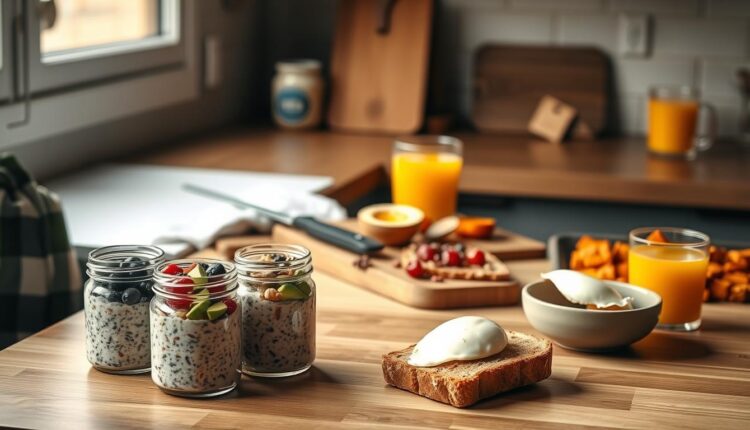Breakfast Meal Prep Beginners Guide With Simple Recipes
Start your day off right with our comprehensive breakfast meal prep beginners guide, featuring easy meal prep recipes and tips. no stress required!
Ever feel like mornings are a race against the clock? I’ve been there. That’s why I want to share a game-changer: planning your first bite of the day ahead of time. Imagine opening your fridge to find ready-to-eat options that boost your energy—no chaos required.
This approach isn’t about perfection. It’s about creating routines that fit your life. Whether you’re juggling work, kids, or both, a little prep helps you skip the “what’s for breakfast?” scramble. Plus, studies show that fueling your body right early can sharpen focus all morning.
We’ll focus on easy recipes with ingredients you already know—think oats, eggs, and fresh fruit. No fancy gadgets or pricey superfoods. I’ll walk you through batch-friendly ideas that stay fresh for days and take 15 minutes to assemble. You’ll learn how to store them, reheat them, and even freeze extras.
Best part? Everything here works for tight budgets and tighter schedules. Let’s build habits that stick—one delicious jar of overnight chia pudding at a time.
Breakfast Meal Prep for Beginners
Imagine beginning each day with calm instead of chaos. That’s what happens when you invest 90 minutes upfront to set up your mornings. I’ve found this strategy transforms rushed decisions into intentional choices—and science backs it up. Research shows people who plan their first meal consume 30% more nutrients on average.
Why Make This a Habit?
Prepping ahead solves two big problems: decision fatigue and time scarcity. You’ll avoid grabbing sugary snacks when hunger strikes. Plus, batch cooking cuts weekly costs—one study found households save $25/week this way.
“Planning your morning fuel is the ultimate act of self-care,” notes a dietitian I work with. “It ensures balanced nutrition without last-minute compromises.”
Simple Solutions That Work
Think beyond basic toast. Try these no-fuss options:
| Recipe Type | Prep Time | Storage |
|---|---|---|
| Overnight Oats | 5 mins | 4 days |
| Egg Muffins | 15 mins | 5 days |
| Chia Pudding | 7 mins | 3 days |
| Breakfast Burritos | 20 mins | Freezer-friendly |
Mix sweet and savory flavors to keep things exciting. Use what’s seasonal—berries in summer, apples in fall. Store items in clear containers so you remember what’s available.
Make sure meals are stored in airtight containers to maintain freshness and prevent spoilage.
Meal Prepping and Its Benefits
What if your mornings could start with ease instead of urgency? I’ve seen firsthand how dedicating a small window to plan ahead reshapes entire weeks. Let’s explore why this practice works—and how it creates ripple effects beyond your kitchen.
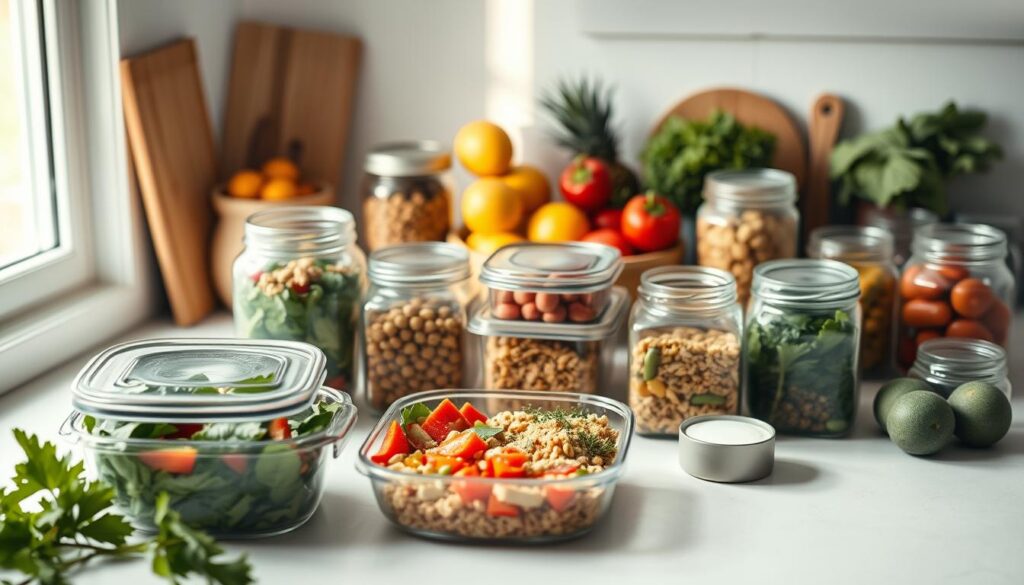
Time Savings and Convenience
Prepping cuts morning chaos by 80% in my experience. Instead of scrambling daily, you’ll grab ready-made options like overnight oats or veggie-packed frittatas. One Sunday session fuels four to five days—imagine reclaiming 25+ minutes each morning.
Busy parents and professionals love this system. No more debating what to eat or waiting in drive-thru lines. Your future self will thank you when deadlines loom or kids need attention.
Nutrition and Budget Benefits
Controlling ingredients means avoiding hidden sugars and preservatives. A client saved $37 weekly by swapping café lattes for homemade smoothies. Bulk-buying staples like oats or eggs slashes costs further.
Studies show planned eaters consume 22% more veggies and 15% less processed food. Plus, you’ll reduce waste—leftover roasted sweet potatoes become tomorrow’s breakfast hash effortlessly.
Prepping ahead helps avoid the last-minute scramble and ensures a nutritious start to your day.
Essential Tools and Container Options for Meal Prep
The right tools turn kitchen chaos into calm. I’ve learned that success starts with three basics: reliable containers, tight-sealing lids, and a kitchen scale. But let’s focus on what really makes the difference—your storage choices. Quality matters more than quantity here.

Choosing Reusable Containers
Look for BPA-free options that handle both freezer chills and microwave heat. Glass versions last years and won’t absorb odors—perfect for saucy dishes. Plastic ones? Great for lightweight stacking. My go-to is a mix: glass for wet ingredients, bento-style boxes for portion control.
Glass, Plastic, and Bento Boxes
Compare your options:
| Type | Best For | Care Tip |
|---|---|---|
| Glass | Reheating, liquids | Handwash lids |
| Plastic | Snacks, freezing | Replace yearly |
| Bento | Portion tracking | Separate compartments |
A nutritionist friend swears by square containers: “They maximize fridge space and prevent soggy greens.” For budget-friendly picks, I love stackable sets with interchangeable lids—they grow with your needs.
Pro tip: Match container sizes to your portions. Half-cup jars keep nuts crisp, while 32-ounce ones store chopped veggies. Your food stays fresher when air exposure’s minimized.
Key Ingredients for Nutritious Breakfasts
What’s the secret to morning fuel that keeps you energized? It starts with three pillars: proteins, grains, and fruits. These building blocks work together to balance energy levels and satisfy cravings naturally.
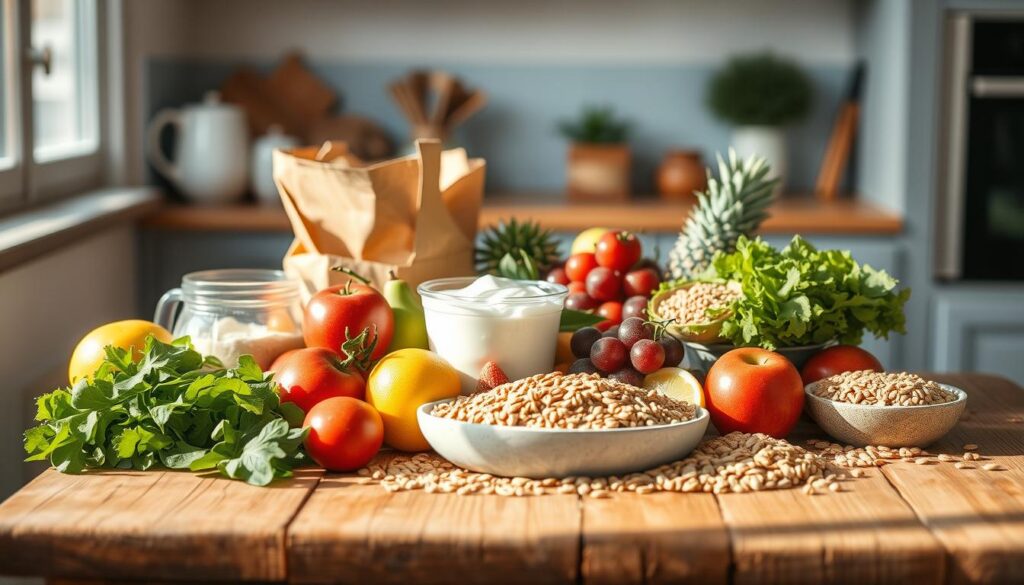
Proteins, Grains, and Fruits
Protein anchors your morning. Eggs, Greek yogurt, and cottage cheese deliver staying power—studies show they help stabilize blood sugar for hours. Pair them with hearty grains like oats or quinoa. These complex carbs release energy slowly, avoiding mid-morning crashes.
Fruits add brightness and vitamins. Bananas boost potassium, while berries pack antioxidants. Frozen options work year-round and cost less. Mix textures: crunchy apples with creamy nut butter or juicy oranges with crispy toast.
| Ingredient | Benefits | Cost Per Serving |
|---|---|---|
| Eggs | 12g protein | $0.25 |
| Rolled Oats | Fiber-rich | $0.15 |
| Frozen Berries | Vitamin C | $0.50 |
| Cottage Cheese | Low-fat calcium | $0.40 |
Budget-Friendly Staples
Great nutrition doesn’t require fancy items. Beans, lentils, and seasonal produce stretch your dollar. Buy oats in bulk—they’re versatile for healthy morning recipes like porridge or baked goods.
Cheese adds flavor without breaking the bank. Grate a block instead of buying pre-shredded—it lasts longer. Store grains in airtight jars to prevent spoilage. Rotate fruits weekly based on sales; apples and oranges often cost under $1/lb.
Popular Breakfast Meal Prep Ideas
Morning fuel shouldn’t be boring—it’s your chance to mix flavors and textures that excite your taste buds. Let’s explore crowd-pleasing options that adapt to sweet or savory cravings while staying make-ahead friendly.
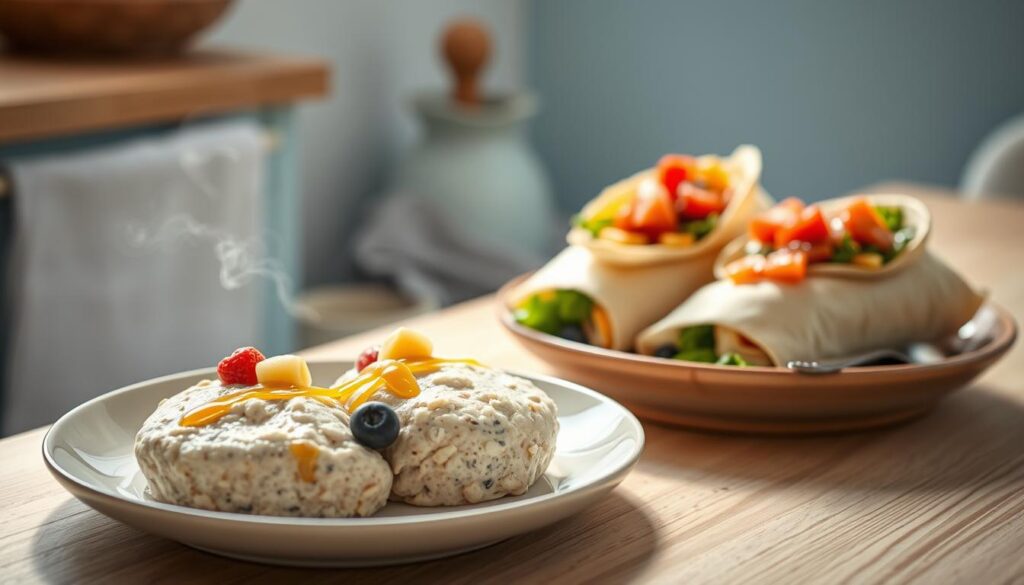
Mix-and-Match Overnight Oats & Smoothies
Overnight oats become new daily with creative layers. Try coconut milk with mango chunks, or almond butter with diced apples. Top with toasted seeds for crunch. Food stylist Jenna Rowe suggests using clear jars: “Seeing colorful layers motivates you to eat well.”
For smoothies, freeze pre-portioned packs. Blend spinach, banana, and protein powder in reusable bags. Morning magic? Add liquid and blend. These stay frosty for 3 months—perfect for hectic weeks.
Protein-Packed Egg Creations
Egg muffins shine with mix-ins like feta and roasted peppers. Bake a dozen on Sunday—they reheat in 45 seconds. Wrap them in whole-grain tortillas with black beans for grab-and-go burritos.
| Dish | Prep Time | Freezer Life |
|---|---|---|
| Veggie Egg Muffins | 18 mins | 2 months |
| Turkey Sausage Burritos | 25 mins | 3 months |
| Spinach Frittata | 30 mins | 1 month |
Pair these with fresh salsa or avocado slices. One client told me her family devours these burritos faster than she can freeze them—proof that planning pays off!
“Learn More About: Breakfast Meal Prep Routine Building For Lasting Habit“
Quick and Easy Recipes for a Healthy Morning
Mornings feel lighter when you’ve got tasty options waiting. I’ve crafted these flavor-packed solutions to keep your energy steady—whether you’re sprinting to meetings or savoring a slow start.

Simple Muffins and No-Bake Cookies
Whip up banana-oat muffins in one bowl—no mixer needed. Combine mashed ripe bananas, rolled oats, a dollop of almond butter, and cinnamon. Bake at 350°F for 18 minutes. They freeze beautifully for 3 months.
No-bake cookies shine when time’s tight. Mix quick oats, peanut butter, honey, and dark chocolate chips. Roll into balls and refrigerate. Grab two for a 200-calorie boost.
| Recipe | Key Ingredients | Yield |
|---|---|---|
| Pumpkin Muffins | Canned pumpkin, Greek yogurt | 12 servings |
| Almond Joy Bites | Shredded coconut, cocoa powder | 20 pieces |
Wholesome Grain Bowls and Quiches
Layer cooked quinoa with roasted veggies and a fried egg—it’s lunch-worthy at dawn. For quiches, whisk 8 eggs with spinach and feta. Pour into a pie crust and bake 25 minutes. Slice into wedges that reheat in 90 seconds.
Pro tip: Let egg-based dishes cool completely before storing. This prevents rubbery textures. A chef friend once told me, “Low-and-slow reheating preserves creaminess better than microwaving on high.”
Step-by-Step Guide to Prepping Your Week’s Breakfasts
Your week starts the moment you open the fridge. Let me show you how to stock it strategically. With three focused hours, you’ll create morning options that keep energy steady and decisions simple.
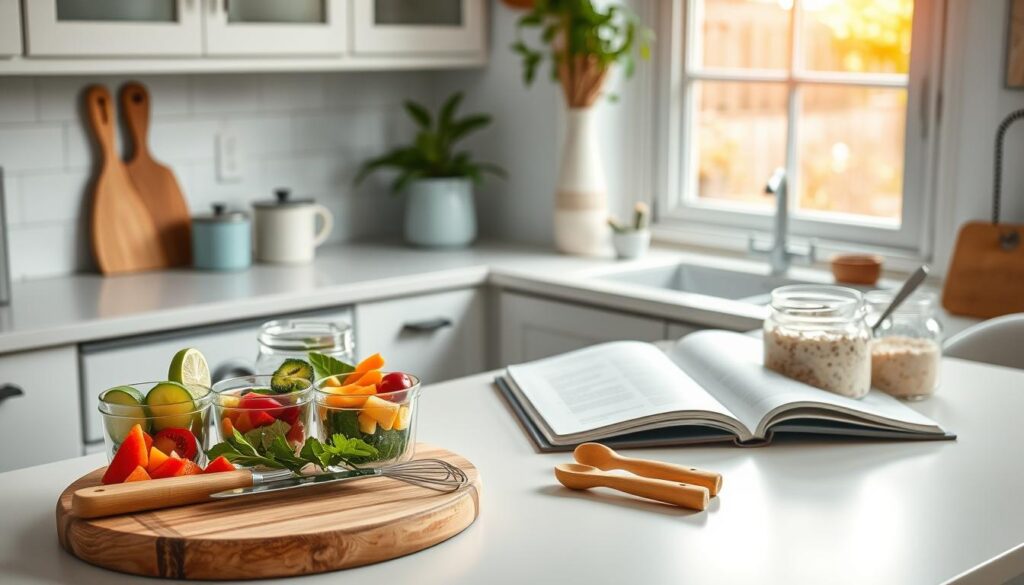
Planning and Shopping Tips
Start with a master list. I group ingredients into proteins, carbs, and toppings to avoid buying duplicates. For example: 18 eggs, 2 cups oats, 1 tub Greek yogurt. Apps like AnyList help track what you already own—no more expired spinach lurking in drawers.
Shop the perimeter first. Fresh produce, dairy, and proteins form your foundation. Bulk bins save money on nuts and seeds. One client cut her grocery time by 40% using this method.
Cooking Techniques and Storage Solutions
Batch-cook components that hold well. Roast sweet potatoes on Day 1—they’ll become hash browns or oatmeal mix-ins. Whisk eggs for muffins and pour into silicone molds. “Components last longer than fully assembled dishes,” explains nutritionist Carla Simmons.
| Storage Method | Best For | Max Days |
|---|---|---|
| Freezer Bags | Burritos, muffins | 90 days |
| Glass Containers | Yogurt parfaits | 5 days |
| Mason Jars | Overnight oats | 4 days |
Label everything with dates. Use Sundays for cooking proteins, Wednesdays for quick refreshes like slicing fresh fruit. Portion snacks into 100-calorie packs during downtime—it takes 10 minutes but saves daily hassle.
Avoid overcrowding containers—too many ingredients can lead to uneven storage and faster spoilage.
“Discover More: Breakfast Meal Prep Complete Guide For Weekly Success“
Starting Your breakfast meal prep beginners guide
That first grocery haul might feel overwhelming—I’ve been there too. Let’s simplify. Begin with three days instead of five. Use leftovers like roasted veggies or cooked quinoa from dinner. These become instant omelet fillings or oatmeal toppings.
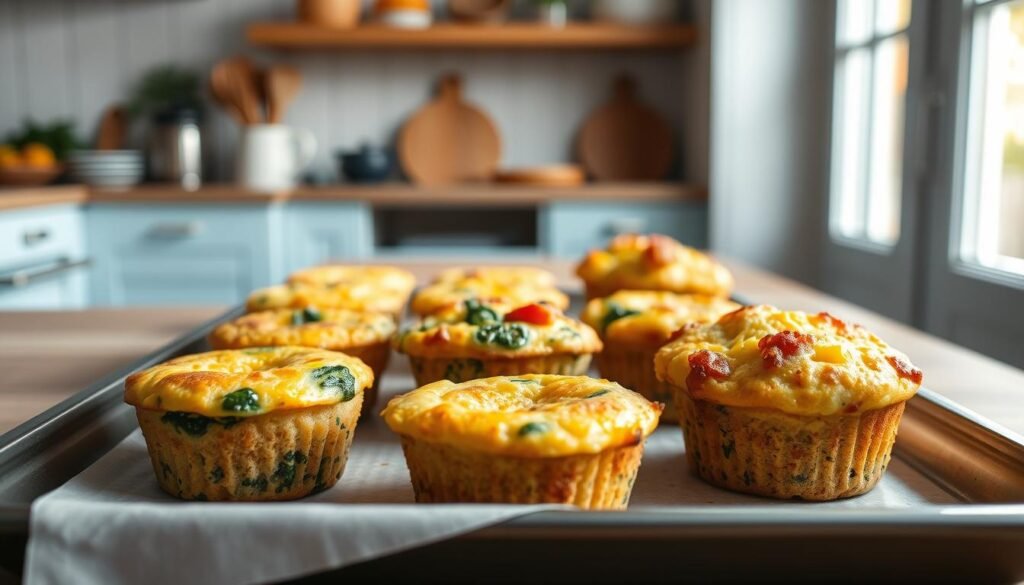
Essential First Steps
Try this starter plan:
- Pick one recipe (egg muffins work great)
- Prep ingredients Sunday evening
- Store in labeled containers
One client told me, “Seeing my fridge organized on Monday changed everything.” Start with familiar flavors—cheddar and spinach muffins take 12 minutes to bake. Freeze extras for backup mornings.
| Day | Task | Time Needed |
|---|---|---|
| Sunday | Chop veggies, boil eggs | 25 mins |
| Wednesday | Refresh fruit, make overnight oats | 10 mins |
Silencing the “What Ifs”
Worried about repetition? Assign themes: “Taco Tuesday” breakfast bowls or “Mediterranean Thursday” frittatas. Rotate two base recipes weekly—variety comes from toppings like salsa or nuts.
Batch-cook muffin batter while roasting dinner veggies. Use silicone cups for easy cleanup. Pro tip: Add 1 tbsp water to egg mixtures—they stay moist when reheated.
“Further Reading: Breakfast Meal Prep Five Ingredients Or Less Recipes“
Budget-Friendly Tips for Efficient Meal Prep
Stretching your grocery budget doesn’t mean sacrificing flavor or nutrition. With smart swaps and strategic planning, you’ll create satisfying options that keep costs low all week. Let’s focus on real-world solutions that work for busy schedules and tight wallets.
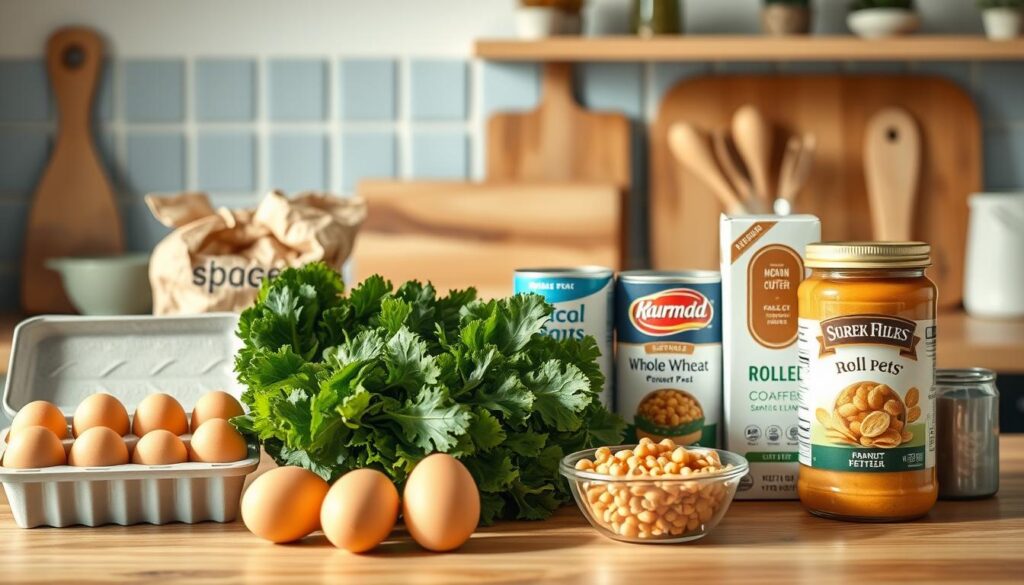
Low-Cost Ingredient Alternatives
Beans are my secret weapon—they’re packed with protein and cost under $1 per can. Mash them into muffin batter or blend into smoothies for creaminess. Chia seeds also deliver big nutrition for small prices. Soak them overnight with oats or sprinkle over yogurt.
| Ingredient | Use | Cost Per Serving |
|---|---|---|
| Almond Butter | Oatmeal swirl | $0.30 |
| Banana | Natural sweetener | $0.25 |
| Frozen Spinach | Egg scrambles | $0.20 |
Smart Shopping and Storage Hacks
Shop bulk bins for nuts and grains—you’ll save up to 40% compared to packaged versions. I store chia seeds and rolled oats in glass jars to maintain freshness. Freeze overripe bananas in slices for smoothies or baking—they last three months.
One client told me, “Labeling containers with dates cut my food waste by half.” Use clear bins to track leftovers easily. Buy generic brands for staples like almond milk—they often match name-brand quality.
Top tip? Repurpose dinner ingredients. Roasted sweet potatoes become breakfast hash, and leftover quinoa transforms into morning bowls. Your wallet—and taste buds—will thank you.
“Related Topics: Make Ahead Breakfast Meal Prep System For Busy Weeks“
Flexible Breakfast Prep Tips to Simplify Busy Mornings
Life moves fast, but your morning routine doesn’t have to. I’ve learned that success comes from designing systems that bend with your schedule—not against it. Let’s create strategies that work whether you’re juggling back-to-back meetings or weekend soccer tournaments.

Minimizing Morning Stress
Keep grab-and-go options front-and-center in your fridge. Pre-portioned mason jars with layered yogurt and granola take seconds to grab. For hot dishes, reheat egg muffins in 45 seconds—just wrap them in a damp paper towel first. One client calls this her “90-second rule”: nothing takes longer than a commercial break.
Use dinner leftovers creatively. Last night’s roasted veggies? Toss them into a morning wrap with scrambled eggs. Cooked quinoa becomes a base for sweet or savory bowls. “Repurposing saves 15 minutes daily,” says nutritionist Mara Simmons.
Flexible Meal Planning
Build a rotating menu that shifts with your energy levels. Try this approach:
| Day Type | Option 1 | Option 2 |
|---|---|---|
| Busy Workday | Freezer-friendly burritos | Chia pudding jars |
| Relaxed Weekend | Customizable omelet bar | Build-your-own toast station |
Keep a smoothie stash for chaotic days. Blend spinach, banana, and protein powder in reusable bags—just add liquid when needed. For variety, rotate two base recipes weekly and change toppings like nuts or fresh herbs.
“Explore More: 12 Healthy Breakfast Meal Prep Ideas For Busy Mornings“
Overcoming Common Meal Prep Challenges
Hitting a wall with your routine? I’ve seen even seasoned planners struggle with two big hurdles: keeping flavors exciting and textures crisp. Let’s tackle these head-on with simple tweaks that revive your enthusiasm.
Spice Up Your Rotation
Swap one ingredient weekly to break monotony. Try feta instead of cheddar in egg muffins, or almond butter in place of peanut sauce. Theme days work wonders—”Mediterranean Monday” with sun-dried tomatoes and olives adds novelty without extra effort.
Use this formula for endless combos:
| Base Ingredient | Mix-Ins | Flavor Profile |
|---|---|---|
| Scrambled Eggs | Pesto + cherry tomatoes | Italian |
| Oatmeal | Cocoa powder + raspberries | Decadent |
| Greek Yogurt | Lemon zest + honey | Citrusy |
Lock In Freshness
Separate wet and dry components using silicone cups in containers. Store dressings in tiny jars—screw them onto lids for drip-free transport. A chef friend taught me this trick: “Line veggie containers with paper towels to absorb excess moisture.”
For crunch retention:
- Toast nuts weekly
- Pack granola separately
- Use airtight glass jars
Remember—small changes make big differences. Rotate two base recipes monthly and experiment with global spices. Your taste buds (and fridge) will thank you!
Double-check your freezer temperature to prevent food from thawing and refreezing, compromising safety.
Read More:
Transforming your mornings starts with one simple choice—preparing ahead. Think of those jars of overnight oats with chia seeds waiting in your fridge, or protein-packed egg muffins you grab on busy days. These small acts add up to calmer starts and steadier energy.
Remember: success lies in smart systems. Use freezer-friendly burritos for hectic weeks, or layer Greek yogurt with berries for instant bowls. Rotate recipes like savory frittatas and sweet oat bakes to keep things fresh. Batch-cook components during downtime—roast veggies while dinner simmers, or blend smoothie packs for three-minute fixes.
This isn’t about perfection. It’s about progress. Whether you’re fueling workdays or weekend adventures, prepped meals give you back precious minutes. One client told me, “Knowing my food’s ready lets me focus on what matters most.”
Ready to taste the difference? Start with one recipe this week—maybe those almond butter oatmeal jars or turkey sausage wraps. Share your creations online and tag me! Together, we’re building kitchens where good mornings thrive.
Savory Cottage Cheese Breakfast Bowls
Protein-packed cottage cheese bowls with roasted veggies and seeds - a savory twist on breakfast meal prep that keeps you full for hours. Ready in 15 minutes and stays fresh for 4 days.

Nutrition Information
Equipment Needed
- Baking sheet
- Mixing bowls
- 4 (16 oz) glass meal prep containers
Ingredients
-
2 cups low-fat cottage cheese
-
1 pint cherry tomatoes, halved
-
1 English cucumber, diced
-
1 red bell pepper, diced
-
1 tbsp olive oil
-
½ tsp garlic powder
-
½ tsp dried dill
-
¼ tsp black pepper
-
¼ cup sunflower seeds
-
2 tbsp fresh chives, chopped
-
1 avocado, sliced (add fresh before serving)
Instructions
Recipe Video
5 Cottage Cheese Breakfast Bowls - Budget Bytes
Cottage cheese breakfast bowls are an inexpensive and easy way to meal prep a high-protein breakfast. Five flavors pictured in the video.

